Diagnosis of the fuel system. * The process has begun. Diagnosis of fuel pump and fuel pressure regulator. Check and flush injector
If a gasoline engine “tupit” or “podtraivaet” when it is idling, the tachometer needle jumps, it is immediately difficult to determine what the problem is. The most probable causes are: a malfunction in the fuel supply equipment or a strong wear of the engine cylinder head (compression drop). These two parameters are usually diagnosed one after another. To assess the compression in the engine, we have our own article, this one is dedicated to diagnostics fuel pump (gasoline pump), checking the operation of the injector and how to wash the injectors when they are contaminated.
Diagnosis of fuel pressure in the car pressure gauge
Any vehicle fuel system is a vicious circle. Gasoline under pressure, pumped by the pump comes from the tank through fuel filter to the fuel rail: to the injectors and fuel pressure regulator, and the unused fuel is returned back to the tank. On each of the elements associated with the passage of gasoline through it, a pressure change in one direction or another is possible.
The amount of injected gasoline depends on the time of the injector, the pressure inside the fuel rail and the pressure (vacuum) inside the intake manifold. In order to take into account these three factors and more accurately calculate the amount of fuel injected, the systems fuel pressure control. It maintains the pressure difference: the gasoline pressure at the nozzle and the air pressure in the intake manifold, the excess gasoline is sent back to the tank on the return line.
Due to wear or incorrect operation, the regulator may reduce or increase the pressure in the fuel rail. As a result, we have: a shortage or overflow of fuel and loss of power in the engine.Also, wedging of the valve may occur, in this case, the pressure in the fuel rail will not change regularly, as a result of which there may be a non-steady engine operation, jerking during acceleration.
Fuel rail pressure is an important parameter in diagnostics fuel equipment. After all, it depends on the composition of the fuel mixture, respectively, and the behavior of the car in different modes operation. Therefore, the diagnosis of the petrol engine injection system is an important component in the overall engine diagnostics.
Types of fuel pressure gauges
For the simplest diagnosis, you will need a fuel pressure gauge. The scale of the gauge must be at least 7 bar. The best option for the price and quality suitable for personal use or a small car service device. It allows you to assess the status of the following systems: pump pressure, pump performance, leakage, fuel filter clogging, check the operation of the pressure regulator. The set of adapters included in the kit allows you to measure the pressure in the fuel system on all cars of domestic and many imported cars. Diagnosing them is quite simple, you can do it yourself.
In car service stations, pressure gauges use more professional kits like: , a set of adapters in which, allows you to connect at various points to the power system of the car on most car brands.
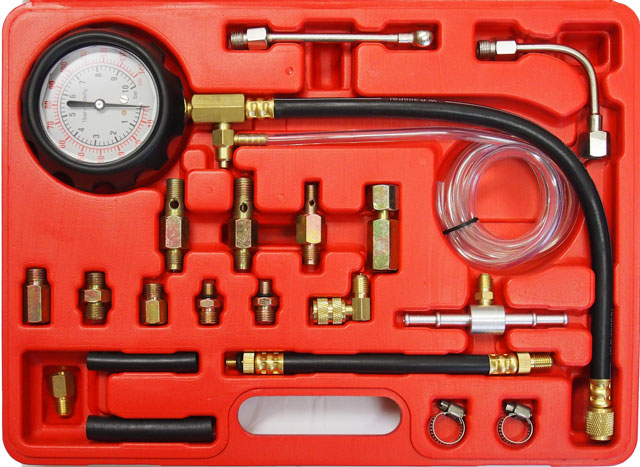
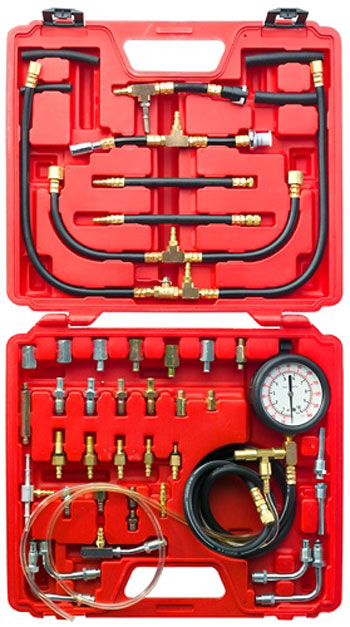
Before starting the diagnosis, it is necessary to thoroughly inspect the entire fuel line, ensure its integrity, absence of smudges, and corrosion. It is also necessary to check the operability of the electrical components of the fuel equipment.
On the engine running, the pressure should correspond to the passport data for the corresponding car brand. For example: the normal fuel pressure for the VAZ, GAZ, UAZ is 2.8-3.2 bar. The cause of low pressure is usually associated with problems in the flow line, and the reason high pressure - with problems in the back.
Diagnosis and flushing of the injector
The injector is a simple solenoid valve designed to accurately meter gasoline and spray it into the combustion chamber. During the operation of the vehicle, components resembling bitumens and varnishes are released from the fuel. The less fuel quality, the more of these impurities. They accumulate on the metering elements of the injectors and in the fuel rail.
The fuel deposits from the engine oil entering the engine intake system through the crankcase ventilation system are added to the fuel deposits here, especially when the engine is worn out. Due to these deposits there is a reduction in flow areas and reduced adjustment of the air-fuel mixture towards its depletion.
To bring the injector out of its normal operating condition, it doesn’t need much. The bay of low-quality fuel, movement in the urban cycle and for short distances with an insufficiently heated engine leads to the fact that deposits in the injectors form more quickly than they dissolve by detergent additives contained in gasoline. Reducing the throughput of one injector by 8-10% is enough to start misfiring. If this happens, unburned oxygen enters the exhaust system and disables the oxygen sensor.
Another component that must be paid attention to is the throttle. Fuel vapors rising from the intake manifold are usually deposited on the throttle and adjacent parts. The result is a change in the proportions of the air-fuel mixture. To detect this pollution is quite difficult. Aerosol solvent is very suitable for cleaning the droseln valve.
Injector testing
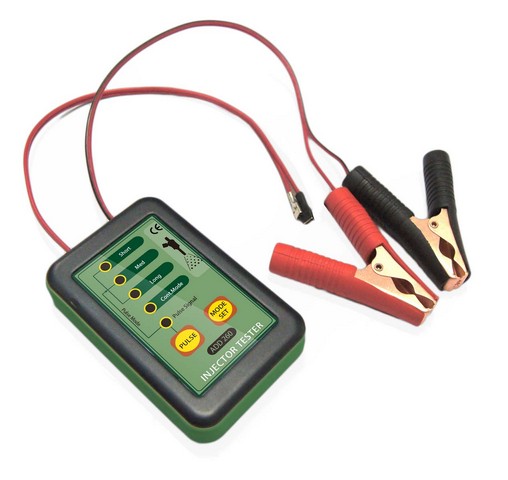 Testers and motor testers are used to diagnose the injector. Simple and convenient device for testing injector —
. It is designed to test the performance of gasoline vehicles injectors.
Testers and motor testers are used to diagnose the injector. Simple and convenient device for testing injector —
. It is designed to test the performance of gasoline vehicles injectors.
The tester allows you to check the performance and condition of the injectors, and then help to clean them in an ultrasonic bath using special software that allows you to create different pulsations, simulating the work of the nozzle. The injector tester ADD260 connects to the injector and checks its performance in various pulsation modes. It is used in conjunction with a fuel rail pressure gauge, for example HS-0020 or TU-443.
First, they create a nominal pressure in the fuel rail, turn off the engine and turn on the injector tester in various pulsation modes to detect the pressure drop in the fuel rail. This operation is performed on each injector and each pulsation mode. Diagnostics allows you to identify the injector performance in different modes, which allows to make a conclusion about the state of the injector (clean injector, clogged, non-working injector).
If the tester shows that the nozzle is clogged, then rinse it. Two main methods of cleaning the injectors are currently used: Flushing the injector with liquid without removing the injectors from the engine and washing the removed injectors on the stand usually also adds an ultrasonic bath.
Flushing the injector on the engine
This is the simplest option, since dismantling them, especially in the latest engine models, can be a significant problem. It is usually carried out periodically with an interval of 15-25 thousand kilometers of the car. The passage of solvent through the injector also quite effectively cleans the valves and the internal surfaces of the combustion chamber. The procedure itself takes in this case from 30 minutes to 1 hour.
For flushing, you can use professional equipment, or you can make one yourself (there are quite a few articles and clips on the Internet on the topic “how to flush the injector yourself”).
With such flushing of the injectors, you should know: severely clogged injectors prevent the penetration of a sufficient amount of solvent, the same applies to caked deposits. In these cases, the flushing time increases. If, even after several tens of minutes of flushing, the engine does not start working better, the injectors should be removed from the engine and washed in a more radical way.
We recommend replacing or at least unscrewing and cleaning the spark plugs after the procedure of flushing the injectors. Since during the cleaning process, a large amount of unbound soot particles is formed, which accumulates on the candles and significantly deteriorates their quality. You can also change the oil and filters, as the solvent can get into the oil through the rings and reduce its quality.
From a wide variety of installations, we chose 2. According to their technical characteristics and adapters for their connection to the fuel lines of various makes of cars and accessories for convenience, they are the best available on the market in terms of quality and cheaper in terms of cost.
The units operate from a stationary compressor, an air line at a service station, or a conventional car tire inflation compressor. The pressure is adjusted using the included regulator with a pressure gauge.
Flushing the injector with the engine
A better way to flush the injector is used when the injectors are very dirty. The nozzles are removed, installed on the stand (it can be made independently by adjusting a used fuel rail and a tester to control the injection of injectors of the type ADD260 or a motor tester), to check the spray and performance.
By specifying different modes of operation of the nozzle (frequency and pulse duration) with the use of cleaning solution, each injector can be well cleaned. We recommend that after the end of the washing, turn the nozzle by 180 degrees, install the nozzle of the nozzle into the fuel rail and perform the flushing again in different modes. In this way, the cleaning solution will be pumped in the opposite direction, which is much more efficient in washing the screen filter in the injector. After 5-10 minutes the nozzle is completely cleaned.
To enhance the cleaning effect of the nozzle can be placed for some time in an ultrasonic bath filled with a weak alkaline solution. You can reconnect the ADD260 injectors tester to simulate the operation of the injector solenoid valve. In dynamics, it is better cleaned from carbon deposits.
What liquid to use for flushing the injector
At the moment, manufacturers of fluid for flushing the injector a lot. The most common brands are: Wynn's (Vince) (usually used for heavily contaminated injectors, when the nozzles did not wash at least 30 tonnes of kilometers), LIQUI MOLY (Livvi Moli), Laurel (average efficiency and cleaning reagents), Carbon Clean (intended more for preventive flushing every 15–20 km of run. To save money, you can use our
A diesel engine on a modern car is able to please the owner with many years of work with high performance and power characteristics. However, for this the owner must pay enough attention to the motor. In particular, the fuel system needs high-quality and timely service.
The Quality Service Motor Service in Moscow performs inexpensively comprehensive diagnostics of the diesel engine fuel system using advanced equipment. The high professionalism of our masters allows you to guarantee high accuracy and efficiency of diagnostic work, and their price will be the most beneficial for the client, as evidenced by the many positive reviews of car owners.
Professional diagnostics of the diesel engine fuel system
The functional performance of a diesel engine is highly dependent on the flawless operation of the fuel system. Its faults lead to a deterioration of the operating mode of the power unit. In addition, in case of violations of fuel supply, engine failures can occur rather quickly, to eliminate which you will have to buy expensive parts. Therefore, diagnostics of the diesel engine fuel system, which makes it possible to timely identify emerging problems and to eliminate them relatively cheaply, which is of great importance for the car owner.
Malfunctions of the fuel supply system are quite difficult to determine. At the same time the list of such faults is very extensive. The main and most common problems include:
- violations in the work and failure of the pump;
- numerous types of nozzle faults;
- high pressure fuel leaks;
- airing of the fuel system.
To avoid costly engine repair, the diesel engine fuel system should be diagnosed urgently with any deviations. In most cases, early detection of a malfunction makes it possible to eliminate it quickly and at minimal cost. Otherwise, repair costs can be quite significant. In addition to such emergency cases, our experts recommend performing regular diagnostics during scheduled maintenance of the car. Such diagnostics of the diesel engine fuel system is very valuable in terms of fault prevention and can significantly reduce the cost of possible repairs.
The auto service "Quality Motors" offers the highest level of quality diagnostic work. Our experts have extensive experience and regularly improve their skills. The work uses advanced equipment from leading manufacturers. In particular, the diagnosis of the diesel engine fuel system is carried out using integrated testers.
This is a modern equipment that allows you to identify deviations in the performance of the vast majority of system elements. At the same time, the works are performed without prior dismantling and disassembling of the fuel supply equipment. We also use the methods of instrumental diagnostics. Together, all this allows you to identify any malfunction of the fuel system, even at an early stage. Correspondingly, the efficiency of repair work increases, costs and time for their implementation are reduced.
Estimated prices for services
| № | Name of works | Total cost (rub.) |
| 1 | Boost pressure measurement | from 900 |
| 2 | Scanning control unit error codes, without troubleshooting | from 450 |
| 3 | Diagnostics of technical fluid leaks | from 900 |
| 4 | Cleaning the fuel system | from 1800 |
| 5 | Compression check | from 900 |
| 6 | Turbine Repair | from 9000 |
| 7 | Turbine diagnostics | from 900 |
| 8 | Check camshaft timing | from 1800 |
| 9 | Checking the mechanical nozzle | from 100 |
| 10 | Check the injector COMMON RAIL BOSCH | from 500 |
| 11 | Checking the injection pump with EDC | from 6,000 |
| 12 | Check of TNVD with the mechanical regulator | from 2.520 |
| 13 | Nozzle removal-installation | from 900 |
| 14 | Flushing nozzle on stand | from 900 |
| 15 | Injection angle check | from 1350 |
Please note that this Internet resource is for informational purposes only and under no circumstances constitutes a public offer determined by the provisions of Article 437 (2) of the Civil Code of the Russian Federation. The cost of work varies depending on the brand of car, its age and technical condition.
Car service on Dmitrovka
Moscow, Lobnenskaya street, 17 p.1
Today we will tell how the diagnostics of the fuel system and nozzles of a gasoline engine, both injection and carburetor, are carried out, the main features.
If the engine power fell, the car began to twitch when driving, gasoline consumption increased, dips appear when you press the gas pedal, you may need to diagnose the fuel system. Most of the symptoms that talk about possible problems with it are similar to signs of malfunctions of SHPG. Due to the fact that to diagnose the connecting rod-piston group is much more than the power supply system of a gasoline engine, you need to start with the latter: what if it is in it (in most cases this is exactly what happens).
Diagnostics of gasoline engine injectors and other components of the fuel system
Modern gasoline engines - injection. Those. nozzles are responsible for fuel injection in them. Therefore, consideration of the order of diagnosis of the fuel system should begin with them.
Unlike diesel engines, it is somewhat easier to diagnose the power supply system of a gasoline engine. All - thanks to a simpler design and the absence of huge pressure in the highways.
This is done in the following sequence:
- Check the fuel pump. In the overwhelming majority of cars, you can hear how it starts pumping gasoline into the trunk when you turn on the ignition after parking (you can hear the characteristic buzz). If this does not happen, it makes sense to check his work by applying voltage directly from the battery.
- Measuring the level of fuel pressure in the system. It is produced using a special pressure gauge. Measurement of pressure is done in different places of the fuel line. At the same time, the pump performance and pressure after the fuel filter will be determined (the reason for incorrect operation of the system may be in its clogging), as well as the operation of the pressure regulator (if it fails - only replacement: this element is not repaired).
- Check injectors. To conduct a preliminary assessment of their work, it is enough to remove the ramp and turn on the fuel pump. If drops appear on the nozzles, then there is a leakage. For better diagnostics of the injectors, specialized equipment is required: testers and motor testers for diagnostics without removal, as well as special stands for testing injectors subject to removal from the machine.
- Check gasoline vapor recovery system. The reason may be in its depressurization. If you hear a distinct smell of gasoline, there may be a problem. Also in the composition of this system is a valve that controls the flow of gasoline vapors into the intake manifold. If nothing happens when a 12V voltage is applied to it, the valve is out of order. If you hear a click, then everything is in order.
Of course, the use of an autoscanner will not be superfluous when diagnosing an injection engine power system. Information on many faults will be contained in the ECU. Having received the appropriate error code, you can already know where to "dig."
Features diagnostics fuel system carburetor engine
Machines with carburetor engines still found on our roads. Therefore, they should not be discarded. The process of diagnosing the fuel system of such cars is as follows:
- Visual inspection of fuel lines for leaks and fuel leaks.
- Control of the degree of contamination of the fine filter.
- Diagnostics of the fuel pump with a mechanical drive. Here special attention should be paid to the integrity of the working membranes. Diagnosis is performed by disassembling the node.
- Check the performance of the carburetor. It comes down to finding blockages, coking, and checking the status of the idle channels. Also in the process of diagnostics, the state of the sealing rings is evaluated, how tightly the solenoid valves are screwed in, the degree of development of the needle valve, the size of the nozzles and their clogging, the state of the float. However, depending on the model of the carburetor, there may be some nuances regarding the method of checking the fuel level in the float chamber and other points. Specify these questions in the instructions.
It can be seen that diagnosing the fuel system of a gasoline engine is quite capable of almost any motorist. Difficulties can arise only with testing injectors. To do this, it is better to contact the experts. With the rest, provided you have certain skills and appropriate equipment, problems should not arise.
Before we talk about such a service as a car or fuel supply system, consider its value and main functions. Imagine figuratively: if a car is a whole organism, then the fuel system is a whole group of organs, similar to the circulatory system in the human body, which is responsible for nourishing the heart of the car, that is, the engine, with fuel, cleaning it from extraneous impurities. Accordingly, the main functions of the fuel system of an injection engine (we will speak about it later) are:- gasoline storage;
- gasoline filtration (cleaning);
- supply of gasoline to the engine.
- reduced level of injectivity;
- at idle it starts to work unstable;
- deteriorating dynamics.
The circulatory system includes the following basic elements:
- gasoline storage tank or gas tank;
- fuel filter;
- injection system (including fuel sprayers);
- two fuel wires: one of them feed, and the other drain;
- air supply and purification system;
- gasoline pump;
- exhaust pipe;
- neutralizer;
- the Lambda probe.
The gas tank is isolated from the air, and the EVAP system - Evaporative Emission Control or, in our opinion, the fuel vapor recovery system - is responsible for the exhaust. It includes an adsorber (absorber) consisting of activated carbon and absorbing fuel vapors from the gas tank, preventing them from entering the external atmosphere. Outside, the adsorber is docked with the intake manifold, the power system itself and air filter. The gas pump installed in the gas tank is responsible for bringing the gasoline to the injection system and provides the necessary pressure in the power supply system. If it is required, the reserve pump for pumping gasoline takes over.
Filtering the incoming gas from dirt particles in the fuel line is the fuel filter, usually containing special cartridges with filter paper. A reduction valve (other than direct injection systems) can be built into it, which helps maintain the necessary pressure by draining excess gasoline through the drain fuel wire into the gas tank.
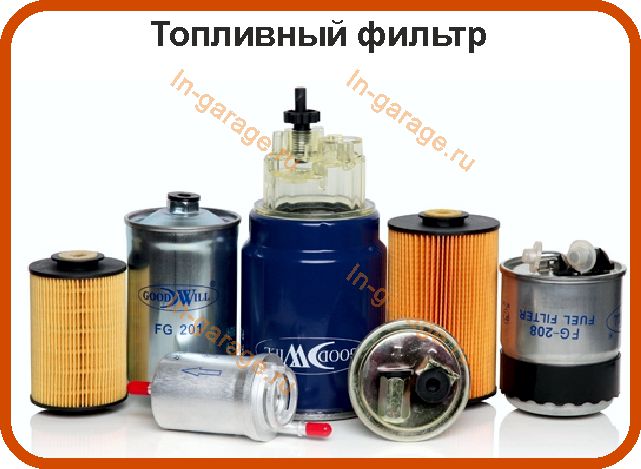
The principle of operation of the fuel supply system
For the carburetor system, the order of operation is as follows: the pump pumps gasoline from the gas tank to the carburetor, and he, in turn, is responsible for the process of mixing it with oxygen in the ratio necessary for the engine to work. This composition is delivered to the cylinders, where it is compressed by pressure and burned in accordance with the cycles of filling and release. On the exhaust wire, the mining goes to the neutralizer, where oxidation of the toxic exhaust takes place to chemically safe formations - H2O, CO2, etc.For the injection system, the order of operation is as follows: the composition of gasoline and air is prepared in the inlet wire before being fed into the cylinders, and fuel injectors are responsible for the injection of gasoline. The process is controlled by electronics based on the system controller and various sensors.
Malfunctions in the fuel supply system
Malfunctions of the fuel system significantly affect the operation of the car's engine. Possible negative manifestations were described at the beginning of this article, and the reasons may be as follows:- clogging fuel and air filters;
- damage to the fuel line;
- incorrect pump operation;
- injectors contamination;
- n incorrect operation of the oxygen sensor;
- and so on.
Therefore, the use of cars with a damaged power system is dangerous primarily for the owners of the transport!
Fuel system diagnostics
There may be several options for the origin of faults. And the medicine in this case is one - timely. fuel system diagnostics and its subsequent repair. In cases where the cause of the failure is unknown, beforePerfect work of the car is guaranteed by the debugged engine fuel system, providing uninterrupted supply of gasoline or diesel fuel to the power unit. Its faults are expressed in increased fuel consumption, deterioration of acceleration, fuel leakage, power loss, unstable idling. All this suggests a possible contamination of the injectors due to the use of poor-quality fuel or problems with the fuel pump.
Troubleshoot will help fuel system diagnostics, produced with the help of modern equipment. Service company "Avtoholl" offers its assistance in this difficult matter. Qualification of our specialists will allow to identify all defects and eliminate the fault.
Main components of the engine fuel system
Regardless of how the power unit is equipped with a car - diesel or gasoline, engine fuel system consists of similar nodes. This is a fuel tank, fuel lines, filters, fuel pump and fuel injection. Since the system is under high pressure during operation, all its components are made of high-strength materials. Especially unpredictable for the owner of the car is its failure.
Major fuel system malfunctions
The specialists service center “Avtoholl” perfectly know all the main faults fuel system gasoline and diesel engines. The quality of any type of fuel at our gas stations is such that the most common cause injector problems. They wear out quickly, requiring complex restoration or replacement, followed by adjustment. A serious problem could be the failure of the fuel pump, a complex and expensive unit.
Less expensive fuel system malfunctions - clogging of the fuel tank and failure of the fuel lines. The contamination of the fuel is such that the filters standing at the entrance to the fuel supply system in the tank do not cope with large particles of dirt. Fuel hoses made of modern composite materials are not eternal, they clog, crack, flow, which significantly changes the pressure in the system. Specialists of the Avtokholl company will reveal all defects, will eliminate them quickly and qualitatively.
Regular flushing of the fuel system
Avoid complicated and expensive fuel system repair help her regular washing. It is recommended to carry it out at least once every 50 thousand kilometers. Produced by flushing the fuel system using special equipment, it replaces itself fuel tank and the pump, and the mixture of fuel and special cleaning agents circulates through the fuel lines. A similar procedure is provided separately for the fuel pump.
The cleaner removes stubborn tar, tar deposits and other harmful formations. Touches flushing the fuel system fuel distributor, injectors, combustion chamber, working surface of the piston and compression rings. As a result, the engine starts to work more stable, its power increases, fuel consumption decreases.
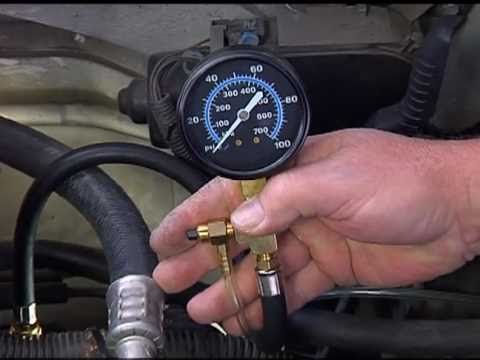
Timely diagnostics and repair
The specialists of the Avtoholl service center carry out quality diagnostics fuel system, which is recommended to be made at least every 30 thousand kilometers. Due to the presence of modern equipment, we detect at least 80% of defects, including hidden ones. This allows fuel system repair faster and less costly. Call our contact numbers and sign up for diagnostics that can extend the life of your car.







